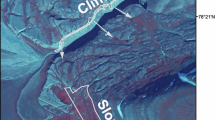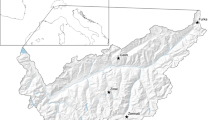Abstract
High-elevation species are expected to be vulnerable to climate warming and to experience dramatic range contractions in the coming decades. Indeed, climate change in high-altitude biota has proceeded at a faster pace compared to lowlands. Understanding basic ecological features of mountain species, such as their foraging ecology, may be useful to further our understanding of the mechanisms dictating species distributions and their responses to global warming, ultimately improving conservation strategies. In this study, we investigated foraging habitat selection of the poorly studied Alpine White-Winged Snowfinch Montifringilla nivalis during the nestling rearing period (June–July) in the Italian Alps. Pair members from 18 different nests were visually followed for 1 day or until we obtained 10 foraging locations. At foraging and control plots (equal numbers per breeding pair; control plots within 300 m of the nest, the average exploited radius according to literature) we recorded habitat variables (habitat types/heterogeneity, sward height, slope, solar radiation). We built models of foraging habitat selection and evaluated whether the selection of climate-related variables varied with temperature and season progression. Snowfinches preferred to forage at colder (low solar radiation) sites, with snow patches and short grasses, some boulders and bare ground, and shifted towards sites with increasingly lower solar radiation after the first week of July. Snow patches are likely to provide both arthropod fallout and suitable sites for invertebrates at their melting margins. Short herbaceous layers likely improved invertebrate detectability in addition to their abundance. These results suggested that climate change may impact on the foraging ecology of this species: warming may reduce the availability of snow patches and favor a denser and taller sward, and may reduce the time frame within which melting snow patches are highly profitable. Hence, the fine-scale habitat requirements of foraging Snowfinches highlight the species’ potential high sensitivity to anthropogenic climate warming.
Zusammenfassung
Futterhabitatwahl bei Schneefinken während der Nestlingsaufzucht Es ist zu erwarten, dass Arten der Hochlagen anfällig sind gegenüber Klimaerwärmung, und dass sie in den kommenden Jahrzehnten eine dramatische Verkleinerung ihres Lebensraumes erfahren. In der Tat ist der Klimawandel in hochgelegenen Biota schneller fortgeschritten als in niedriger gelegenen Gebieten. Das Verständnis grundlegender ökologischer Merkmale von Gebirgs-Arten, wie ihre Futtersuche, könnte nützlich sein, um unser Verständnis für die Mechanismen zu erweitern, die die Verbreitung einer Art und ihre Reaktion auf globale Erwärmung bedingen, um schließlich die Strategien im Artenschutz zu verbessern. In dieser Studie untersuchten wir die Auswahl von Futterhabitaten beim wenig erforschten Schneefinken (Montifringilla nivalis) in den italienischen Alpen während der Zeit der Nestlingsaufzucht (Juni-Juli). Die Individuen der Paare aus 18 verschiedenen Nestern wurden über einen Tag, oder bis wir 10 Futterplätze aufgenommen hatten, verfolgt. An Futter- und Kontrollplätzen (gleiche Anzahl bei Brutpaaren; Kontrollplätze innerhalb von 300 m vom Nest, laut Literatur der mittlere ausgenutzte Radius) nahmen wir Habitat-Variablen auf (Habitattyp/-heterogenität, Höhe der Grasnarbe, Neigung, Sonneneinstrahlung). Wir erstellten Modelle für eine Futterhabitat-Auswahl und überprüften, ob sich die Auswahl von klimabezogenen Variablen mit der Temperatur und fortschreitender Saison änderte. Schneefinken zogen es vor, an kälteren Stellen (geringere Sonneneinstrahlung) mit Schneeflecken und kurzem Gras, einigen Steinen und offenem Boden auf Futtersuche zu gehen, und wechselten nach der ersten Juli-Woche an Stellen mit zunehmend geringerer Sonneneinstrahlung. Schneeflecken stellen vermutlich sowohl Arthropoden-Fallout zur Verfügung als auch geeignete Stellen für Invertebraten an ihren Rändern. Kurze krautige Bewüchse erleichterten das Auffinden der Invertebraten und vergrößerten deren Abundanz. Diese Ergebnisse legen nahe, dass der Klimawandel einen Einfluss haben könnte auf die Futtersuche dieser Art: eine Erwärmung könnte die Verfügbarkeit von Schneeflecken reduzieren und eine dichtere und höhere Grasnarbe bevorzugen, und sie könnte das Zeitfenster verkleinern, in der schmelzende Schneeflächen hochprofitabel sind. Daher betonen die kleinräumigen Bedürfnisse von Schneefinken an ihr Futterhabitat die potentiell hohe Empfindlichkeit dieser Art gegenüber anthropogener Klimaerwärmung.



Similar content being viewed by others
References
Antor RJ (1995) The importance of arthropod fallout on snow patches for the foraging of high-alpine birds. J Avian Biol 26:81–85
Arlettaz R, Maurer ML, Mosimann-Kampe P, Nusslé S, Abadi F, Braunisch V, Schaub M (2012) New vineyard cultivation practices create patchy ground vegetation, favouring Woodlarks. J Ornithol 153:229–238
BirdLife International (2015) European red list of birds. Office for Official Publications of the European Communities, Luxembourg
Brambilla M, Fulco E, Gustin M, Celada C (2013) Habitat preferences of the threatened Black-eared Wheatear Oenanthe hispanica in southern Italy. Bird Study 60:432–435
Brambilla M, Bergero V, Bassi E, Falco R (2015) Current and future effectiveness of Natura 2000 network in the central Alps for the conservation of mountain forest owl species in a warming climate. Eur J Wildl Res 61:35–44
Brambilla M, Gustin M, Vitulano S, Negri I, Celada C (2016a) A territory scale analysis of habitat preferences of the declining Ortolan Bunting Emberiza hortulana. Bird Study 63:52–57
Brambilla M, Pedrini P, Rolando A, Chamberlain DE (2016b) Climate change will increase the potential conflict between skiing and high-elevation bird species in the Alps. J Biogeogr. doi:10.1111/jbi.12796
Braunisch V, Coppes J, Arlettaz R, Suchant R, Zellweger F, Bollmann K (2014) Temperate mountain forest biodiversity under climate change: compensating negative effects by increasing structural complexity. PLoS One 9(5):e97718
Catzeflis F (1975) Remarques sur la nidification rupestre de la Niverolle. Nos Oiseaux 33:64–65
Chamberlain D, Arlettaz R, Caprio E, Maggini R, Pedrini P, Rolando A, Zbinden N (2012) The altitudinal frontier in avian climate change research. Ibis 154:205–209
Chamberlain DE, Negro M, Caprio E, Rolando A (2013) Assessing the sensitivity of alpine birds to potential future changes in habitat and climate to inform management strategies. Biol Conserv 167:127–135
Chamberlain D, Brambilla M, Caprio E, Pedrini P, Rolando A (2016a) Alpine bird distributions along elevation gradients: the consistency of climate and habitat effects across geographic regions. Oecologia 181:1139–1150
Chamberlain DE, Pedrini P, Brambilla M, Rolando A, Girardello M (2016b) Identifying key conservation threats to Alpine birds through expert knowledge. Peer J 4:e1723
Charmantier A, Gienapp P (2014) Climate change and timing of avian breeding and migration: evolutionary versus plastic changes. Evol Appl 7:15–28
Cramp S, Perrins CM (eds) (1994) The birds of the Western Palearctic, vol VIII. Oxford University Press, Oxford
Dirnböck T, Essl F, Babitsch W (2011) Disproportional risk for habitat loss of high-altitude endemic species under climate change. Global Change Biol 17:990–996
Friedman JH (1991) Multivariate adaptive regression splines. Ann Stat 19:1–67
Gobiet A, Kotlarski S, Beniston M, Heinrich G, Rajczak J, Stoffel M (2014) 21st century climate change in the European Alps—a review. Sci Tot Environ 493:1138–1151
Grangé J-L (2008) Biologie de reproduction de la Niverolle Alpine Montifringilla nivalis dans le Pyrénées occidentales. Nos Oiseaux 55:67–82
Hosmer DW, Lemeshow S (1989) Applied logistic regression. Wiley, New York
Inouye DW, Barr B, Armitage KB, Inouye BD (2000) Climate change is affecting altitudinal migrants and declining species. PNAS 97:1630–1633
IPCC (2013) Climate change 2013: the physical science basis. In: Stocker TF et al (eds) Working group I contribution to the fifth assessment report of the intergovernmental panel on climate change. Cambridge University Press, Cambridge, pp 1–14
Jedlikowski J, Brambilla M, Suska-Malawska M (2014) Fine-scale selection of nesting habitat in Little Crake Porzana parva and Water Rail Rallus aquaticus in small ponds. Bird Study 61:171–181
Leathwick JR, Rowe D, Richardson J, Elith J, Hastie T (2005) Using multivariate adaptive regression splines to predict the distributions of New Zealand’s freshwater diadromous fish. Freshw Biol 50:2034–2052
Lu X, Ke DH, Zeng XH, Yu TL (2009) Reproductive ecology of two sympatric Tibetan snowfinch species at the edge of their altitudinal range: response to more stressful environments. J Arid Environ 73:1103–1108
Maggini R, Lehmann A, Zbinden N, Zimmermann NE, Bolliger J, Schröder B, Foppen R, Schmid H, Beniston M, Jenni L (2014) Assessing species vulnerability to climate and land use change: the case of the Swiss breeding birds. Divers Distrib 20:708–719
Milborrow S (2011a) Earth: multivariate adaptive regression spline models. R package version 4.4.3. http://cran.r-project.org/web/packages/earth. Accessed 1 Dec 2015
Milborrow S (2011b) Plotmo: plot a model’s response while varying the values of the predictors. R package 3.1.4. http://cran.r-project.org/web/packages/plotmo. Accessed 1 Dec 2015
Muscio G, Pellegrini GB, Solari M, Tomaselli M, Vanin S, Zanetti A (2005) Ambienti nivali. La vita in un ambiente estremo. Quaderni Habitat N. 10. Ministero dell’Ambiente e della Tutela del Territorio, Museo Friulano di Storia Naturale, Comune di Udine
R Development Core Team (2015) R: a language and environment for statistical computing. R Foundation for Statistical Computing, Vienna
Rosvold J (2016) Perennial ice and snow-covered land as important ecosystems for birds and mammals. J Biogeogr 43:3–12
Sekercioglu CH, Schneider SH, Fay JP, Loarie SR (2008) Climate change, elevational range shifts and bird extinctions. Conserv Biol 22:140–150
Strinella E, Ricci F, Vianale P (2007) Uso dell’habitat nel Fringuello alpino (Montifringilla nivalis) in periodo riproduttivo in un’area sub-antropizzata: Campo Imperatore (Gran Sasso-Abruzzo). Alula 14:107–114
Strinella E, Vianale P, Pirrello S, Artese C (2011) Biologia riproduttiva del Fringuello alpino Montifringilla nivalis a Campo Imperatore nel Parco Nazionale del Gran Sasso e Monti della Laga (AQ). Alula 18:95–100
Tarquini S, Vinci S, Favalli M, Doumaz F, Fornaciai A, Nannipieri L (2012) Release of a 10-m-resolution DEM for the Italian territory: comparison with global-coverage DEMs and anaglyph-mode exploration via the web. Comput Geosci 38:168–170
Vickery J, Arlettaz R (2012) The importance of habitat heterogeneity at multiple scales for birds in European agricultural landscapes. In: Fuller RJ (ed) Birds and habitat. Relationships in changing landscapes. Cambridge University Press, Cambridge
Acknowledgments
We are very grateful to E. Strinella, G. Volcan, E. Bassi, P. Trotti for helpful advice, and to two anonymous reviewers for very useful comments.
Author information
Authors and Affiliations
Corresponding author
Additional information
Communicated by T. Gottschalk.
Rights and permissions
About this article
Cite this article
Brambilla, M., Cortesi, M., Capelli, F. et al. Foraging habitat selection by Alpine White-winged Snowfinches Montifringilla nivalis during the nestling rearing period. J Ornithol 158, 277–286 (2017). https://doi.org/10.1007/s10336-016-1392-9
Received:
Revised:
Accepted:
Published:
Issue Date:
DOI: https://doi.org/10.1007/s10336-016-1392-9




